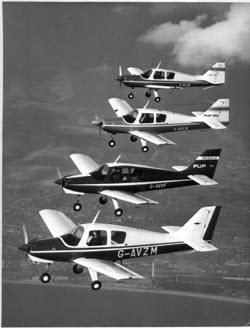At the time of the
formation of Beagle, it
was envisaged that the
single engine line would
be based on the existing
Miles design for the
Messenger replacement, the
M.117, a 2/3 seat tourer/trainer
using a 100 hp Rolls-Royce
Continental 0-200A.
However, due to production
difficulties, this was
idea was abandoned.
Following a careful market
evaluation, a completely
new design resulted in the
announcement, in 1965, of
the all metal Pup range
with engines ranging from
100 hp up to 210 hp and
with fixed or retractable
undercarriage.
The first to be built
would be a semi aerobatic
2-seat B-121C, with a 100
hp RR Continental 0-200,
to be joined later by a
4-seat B-121T Pup Major
with an RR Cont 0-300,
then a fully aerobatic
B-121M Bull Pup fitted
with a 210 hp Cont 10-360
and clipped wings: a Twin
Pup Major was also
projected. The first
prototype B.121C (G-AVDF)
made its first flight of
75 minutes from Shoreham
in the hands of the late
'Pee Wee' Judge on
Saturday 8 April 1967.
Later flight trials
confirmed that performance
and handling were all that
had been anticipated.

Early Pup publicity
photograph
Following further market
research and favourable
reaction to the 1966
Farnborough mock-up
exhibit, it was decided to
re-plan the introduction
of the higher powered
versions. The 100 hp
2-seat Pup 1 was to sell
for £3495 and the 150 bp
Lycoming 0-320A-2B powered
Pup 150 (or Pup 2) would
sell at £4250. The biggest
in the initial production
range would be the Pup 180
selling at £5400. To
simplify production
initially, all Pups would
be stressed for positive-g
aerobatics, and the
retractable undercarriage
option would be offered at
a later date. Orders for
over 250 aircraft were
received within the first
12 months, thus exceeding
even the most optimistic
production estimates.
At Shoreham, the second
airframe built was used
for ground structural
tests, and was followed by
the first 150 (G-AVLN) in
January 1968, and the
first production 100 (G-AVZM)
which flew on 23 February
1968. Early modifications
included an increase to
the fin and rudder area
and the addition of
anti-spin strakes to the
150 which, to simplify
production, were
incorporated in both
versions. The first
customer delivery was
GAVZM (on loan) to the
Shoreham school of flying
on 9 April 1968 followed
by the first of their own
aircraft, G-AVZN, which
had been used as the
Hanover show demonstrator:
this was later joined by
G-AVZP, 'WDZ and 'WEC.
Other early customers were
Flairavia at Biggin Hill
and Casiar of Carlisle.
In August '68 the first
overseas delivery was made
to Roja Aviation, Beagle's
Swiss agents, followed by
deliveries to the US. The
prototype G-AVLM was
re-engined with a
fuel-injected Lycoming and
re-designated the Pup 160
or Pup 3. This was
developed for the Iranian
Civil Aviation Training
Organisation to whom 8 of
this version were
delivered during the first
half of 1969. With the
pace of production
increasing by the end of
1968 to one aircraft per
week, examples were
dispatched to Beagle's
agents where sales of
their products had
previously been made.
These aircraft were crated
and sent to Australia, New
Zealand, Finland, Sweden,
Ireland and Austria. Sales
efforts to South America
came to nothing as well as
to Belgium. However, in
October 1969, 2 aircraft
were sold to South Africa
and the Iraqi Flying
Association
took delivery of 4.
Back at home, both the
College of Aeronautics at
Cranfield and the Surrey &
Kent Flying Club became
major users and even
Beagle themselves used G-AXDU
and G-AXOJ as
demonstration and hack
aircraft. In September
1969, certain defects to
the aircraft as well as
the company's poor
customer relations were
brought to the attention
of the general public and
the MD of Shoreham School
of Flying announced that
he was about to sell his
fleet of Pups because of
inadequate co-operation
from Beagle with
rectification. The
problems included brake
and shock-absorber
failure, fuel tank splits,
doors opening in flight
and wing mounting cracks,
all largely attributed to
the comparatively
complicated design which
did not lend itself easily
to mass production. This
also meant that the
aircraft was seriously
under-priced on production
costs alone. Although the
price was increased to
£5,000, a request to the
government for a further
£6M to aid production was
turned down and the
company passed into
receivership. Many of the
remaining completed
aircraft were eventually
sold off to meet
outstanding orders, and
some partly completed
aircraft were in fact
acquired from the receiver
by Domestic Wholesale
Appliances who eventually
sold them off after
completion. Many of the
various spares and
incomplete airframes were
taken to Prestwick for
Scottish Aviation who took
over product support. This
latter role has, of
course, now been taken
over by DHS.
